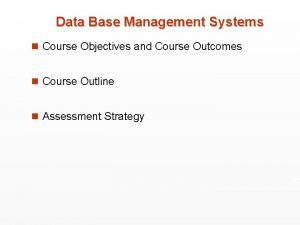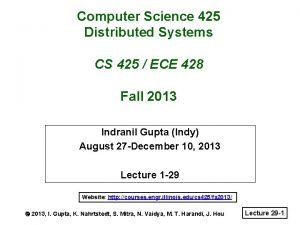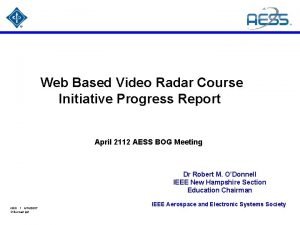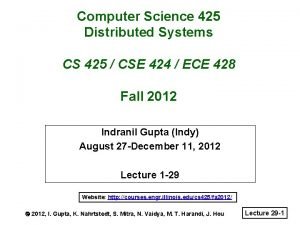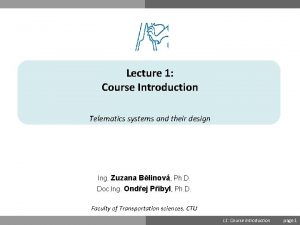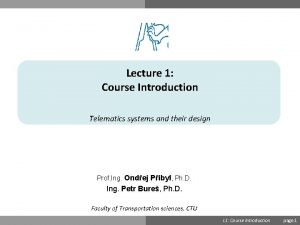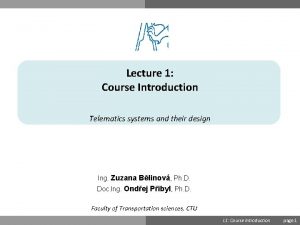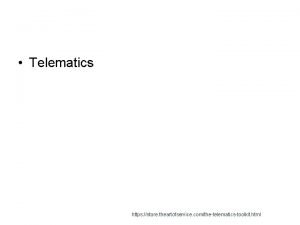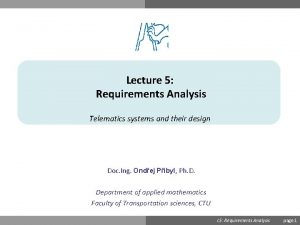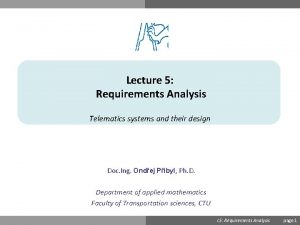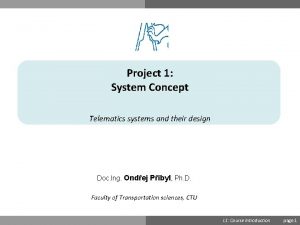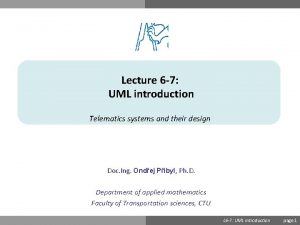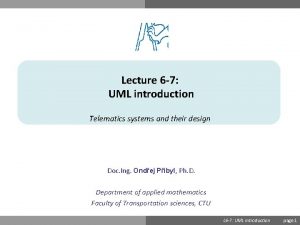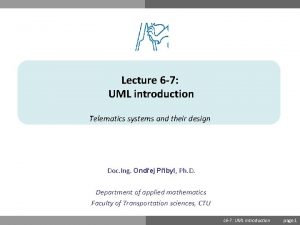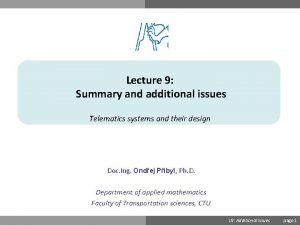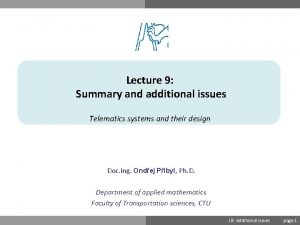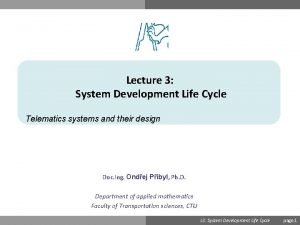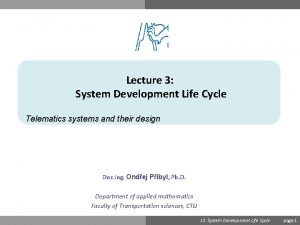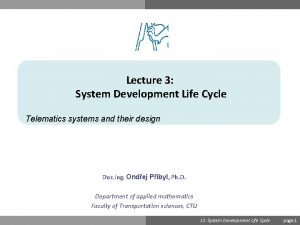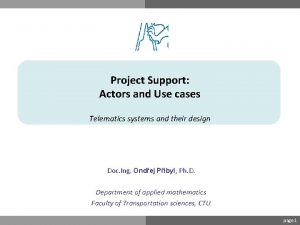Lecture 1 Course Introduction Telematics systems and their

















- Slides: 17

Lecture 1: Course Introduction Telematics systems and their design Ing. Petr Bureš, Ph. D. Doc. Ing. Ondřej Přibyl, Ph. D. Faculty of Transportation sciences, CTU Ondřej Přibyl L 1: Course Introduction page 1

Telematics systems and their design Faculty of Transportation Sciences, CTU Lecture 1 – Overview • • • Course objectives Introduction of the students Course overview Course evaluation Project Ondřej Přibyl, Zuzana Bělinová L 1: Course Introduction page 2

Telematics systems and their design Faculty of Transportation Sciences, CTU Objective of this course • Theoretical and practical objectives of the course • Part I (theory): – To introduce Traffic telematics systems • Part II (design): – To provide an overview of the methodology and major steps in analysis and design of systems • Focus on telematics systems • Best practice approach • Practical application to a selected project • Part I and II running in parallel Ondřej Přibyl, Zuzana Bělinová L 1: Course Introduction page 3

Telematics systems and their design Faculty of Transportation Sciences, CTU Introduction of the students – main topics for discussion • Your background • Experiences with traffic telematics – Theoretical (courses) – Practical (from your country) • Other • Why are you interested in traffic telematics? • What do you expect from this course? Ondřej Přibyl, Zuzana Bělinová L 1: Course Introduction page 4

Telematics systems and their design Faculty of Transportation Sciences, CTU Proposed syllabus (subject to change) Week Topic 1 Course introduction Introduction to telematic systems 2 Introduction to system design Definitions of telematic, telecommunication environment for telematics 3 System Analysis and Design Terminology (players, definitions, main features, …) ITS architecture, ITS organizations, ITS standardization bodies 4 System development life cycle ITS architecture, ITS organizations, ITS standardization bodies 5 System development methodologies GALILEO 6 UML Introduction – Main diagrams (1) Cooperative systems 7 UML Introduction – Main diagrams (2) Cooperative systems Ondřej Přibyl, Zuzana Bělinová L 1: Course Introduction page 5

Telematics systems and their design Faculty of Transportation Sciences, CTU Proposed syllabus (subject to change) Week Topic 8 UML examples Intelligent highway, smart cities 9 Requirement analysis Electronic fee collection 10 CASE Tools Railway telematics 11 Project presentations 12 Course evaluation: Pre-term examination 13 14 Ondřej Přibyl, Zuzana Bělinová L 1: Course Introduction page 6

Telematics systems and their design Faculty of Transportation Sciences, CTU Course materials • Lectures • Individual internet recherché • Internet resources – to be provided by particular topics by the lecturers • Further recommended reading (Part II) – Systems Analysis and Design Methods • • by Jeffrey L. Whitten, Lonnie D. Bentley Publisher: Mc. Graw-Hill Companies, The November 2005 Edition 7 • Several copies available in the library – Methodology for the analysis and design of ITS (in Czech) Ondřej Přibyl, Zuzana Bělinová L 1: Course Introduction page 7

Telematics systems and their design Faculty of Transportation Sciences, CTU Main contact • Course web site – Used for all readings – General information • its. fd. cvut. cz → Courses → Telematic Systems and Their Design (its. fd. cvut. cz/courses/telematic-systems-and-their-design) – Assignment submission • via email • Contact data: – Petr Bureš • Email: burespe 1@gmail. com • Office: Konviktská 20, 5 th floor – Ondřej Přibyl • Email: pribylo@fd. cvut. cz • Office: Na Florenci 25, 4 th floor, Nr. 407 • Personal consultation – On request (e-mail) Ondřej Přibyl, Zuzana Bělinová L 1: Course Introduction page 8

Faculty of Transportation Sciences, CTU Telematics systems and their design Evaluation and grading • Assesment 1. Project • • Up to 45 Points (in separate tasks – see dedicated Table) Demonstration of your understanding particular steps in design of telematics systems • 15 Points ( 5 – formal aspects, 5 – presentation, 5 – technical understanding) • • Maximum: Minimum for assessment: In case of more than 40 points: In case of more than 50 points: 2. Final presentation – • Evaluation: 60 point 31 points +10 extra points to exam +20 extra points to exam Exam – Written test – Max 100 points Points >91 <81, 90> <71, 80> <61, 70> <51, 60> <51 Grade A B C D E F Ondřej Přibyl, Zuzana Bělinová L 1: Course Introduction page 9

Project Overview Ondřej Přibyl L 1: Course Introduction page 10

Telematics systems and their design Faculty of Transportation Sciences, CTU Project: Major objectives • Part I (related to guided discussion): – To prove ability to do background research on a chosen topic – To get familiar with the chosen topic – To summarize and present the important characteristics • Part II (related to a specific system): – To demonstrate understanding of the main steps in system analysis and design (SAD) – To gain experience with one (small scale) project from beginning to the end – To learn how to document / present own ideas – To get familiar with an ITS system Ondřej Přibyl, Zuzana Bělinová L 1: Course Introduction page 11

Telematics systems and their design Faculty of Transportation Sciences, CTU Project: General features • All deliverables will be evaluated according to: – Meeting of the objective – Optimality of the scope and level of details – Structuring – Correctness of the content – Clarity of used pictures and descriptions – Formal requirements (name and scope of the document, authors, date, objectives, topic, main body, references, and others) Ondřej Přibyl, Zuzana Bělinová L 1: Course Introduction page 12

Telematics systems and their design Faculty of Transportation Sciences, CTU Project: General features specific for Part I. • To – prove ability to do background research on a chosen topic – get familiar with the chosen topic and – summarize and present the important characteristics • By participating on guided discussions and presenting interesting news articles (ITS related) • guided discussions topics are at least bit broader than a Design project topic (30 minutes of presentation) could be on completely different topic. • To help students with assignment of the project for the second part of the course. – No real deliverable to the Part I Ondřej Přibyl, Zuzana Bělinová L 1: Course Introduction page 13

Telematics systems and their design Faculty of Transportation Sciences, CTU Project: General features specific for Part II. • Demonstrate your understanding of the topic by addressing also exceptions and special cases (configuration, handling of failures, obtaining of statistical data, and others) • SW to be used – Microsoft products for the reports (MS Word, MS Visio, MS Project and others) – Optionally - dedicated CASE tool • Enterprise Architect not available for students (30 day trial version) • Open source products – – – Visual Paradigm (http: //www. visual-paradigm. com/product/vpuml/) Argo UML (argouml. tigris. org) Star. UML (staruml. sourceforge. net/) Poseidon (http: //www. gentleware. com/) BOUML (http: //bouml. free. fr) Ondřej Přibyl, Zuzana Bělinová L 1: Course Introduction page 14

Telematics systems and their design Faculty of Transportation Sciences, CTU Project: Topics • Examples: – User SW for speed measurement system – System for automated classification of traffic – User SW for variable message signs – SW for a bus ticket automata – IT system for logging for exams at a university – Section speed control system – Speed harmonization system – And others • Students are encouraged to chose a topic of their own (preferably in ITS) Ondřej Přibyl, Zuzana Bělinová L 1: Course Introduction page 15

Telematics systems and their design Faculty of Transportation Sciences, CTU Project: Tasks overview Description Week Assign ed Due Expec ted range Points Task 1 Select/specify topic for the project 1 2 ½ page 0 Task 2 Part I: For each lecture bring up-to date article referring to news in the telematics area 1 Contin uously 2 -3 art. 5 Task 3 Part I: Guided discussion: Describe „an existing“ traffic telematics solution: basic description of the system, its basic parameters and functions (presenting and opposing group) 2 1 per semest er 30 min 10 Task 4 Part II: Briefly describe the project and provide its conceptual scheme with defined subsystems. Provide basic terminology with explanation. 2 6 ~ 3 p. 5 Task 5 Part II: Define graphically all actors in the system and relations among them, and describe their role in text. 6 7 ~ 2 -3 p. 5 Task 6 Part II: Requirements analysis 1) Describe how, from whom and in which form you are to obtain a complete set of requirements for given task. 2) Prepare formally correct SRS document. It has to be structured and examples of the requirements are to be provided. It does not have to be complete on lower hierarchical levels, but the structuring has to be complete. For the areas, which are not going to be filled completely, provide at least a short description what should be provided here (for example: High availability of the system, description of GUI etc. are not described in more details within this paper) 7 9 ~ 5 p. 8 Task 7 Part II: Use case analysis 1) For the defined subsystems create structured UC. 2) Demonstrate traceability among requirements and UC Describe major UC (not all but those critical for the system). The understanding of the different forms should be demonstrated (text, activity diagram, sequence diagram). 9 12 ~ 5 p. 12 Ondřej Přibyl, Zuzana Bělinová L 1: Course Introduction page 16

Telematics systems and their design Faculty of Transportation Sciences, CTU Summary of the next tasks for students • Select/specify topic for the project – Delivery • Project name • One paragraph explaining the project – Due date • Per course website - 24 hours prior to the particular lecture (first task before lecture 13. 10. 2015) • Next week – discussion • Keep in mind to meet all formal requirements! Ondřej Přibyl, Zuzana Bělinová L 1: Course Introduction page 17
 Samsara api documentation
Samsara api documentation Telematics
Telematics Freight telematics
Freight telematics 01:640:244 lecture notes - lecture 15: plat, idah, farad
01:640:244 lecture notes - lecture 15: plat, idah, farad Course title and course number
Course title and course number Stretcher bond t junction
Stretcher bond t junction Chaine parallèle muscle
Chaine parallèle muscle Advanced operating system notes
Advanced operating system notes Articulators
Articulators Lecture sound systems
Lecture sound systems Introduction to biochemistry lecture notes
Introduction to biochemistry lecture notes Introduction to psychology lecture
Introduction to psychology lecture Introduction to algorithms lecture notes
Introduction to algorithms lecture notes Golf course drainage products
Golf course drainage products Course objectives of database management systems
Course objectives of database management systems Distributed systems course
Distributed systems course Radar systems engineering course
Radar systems engineering course Distributed systems course
Distributed systems course














